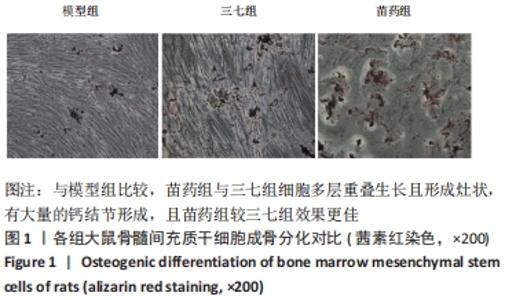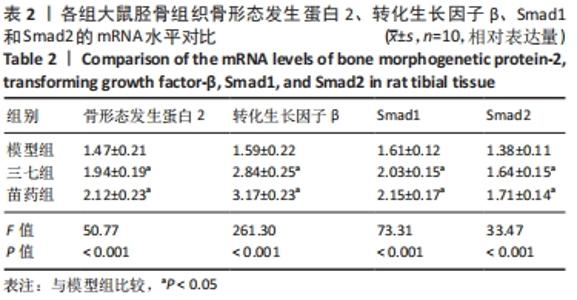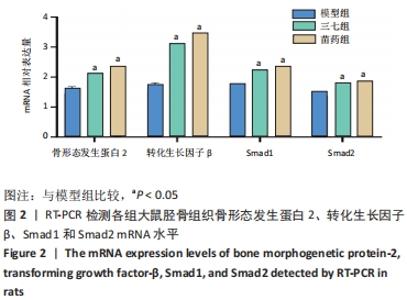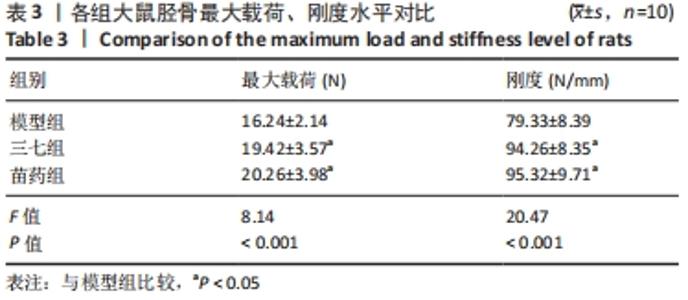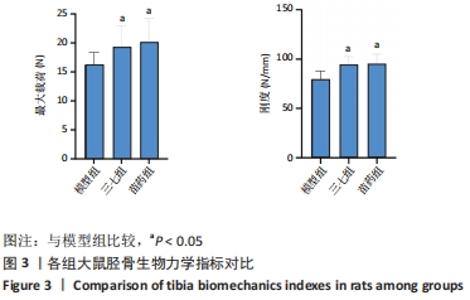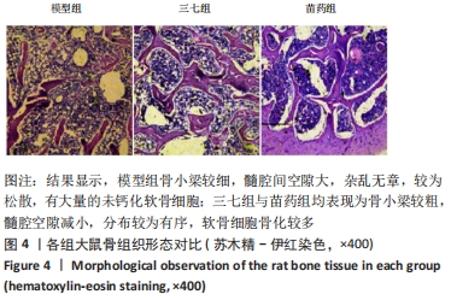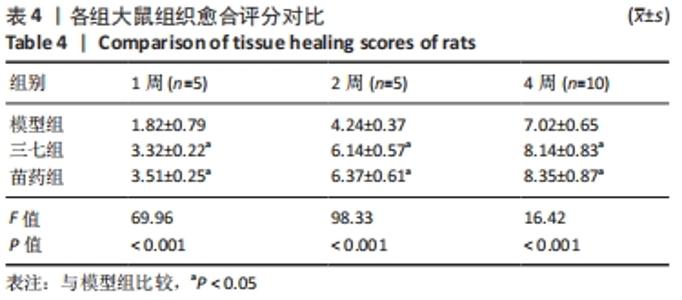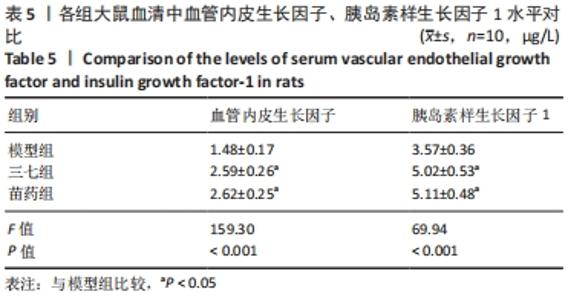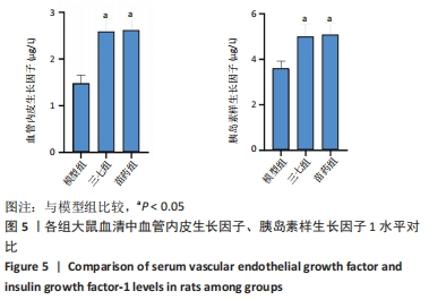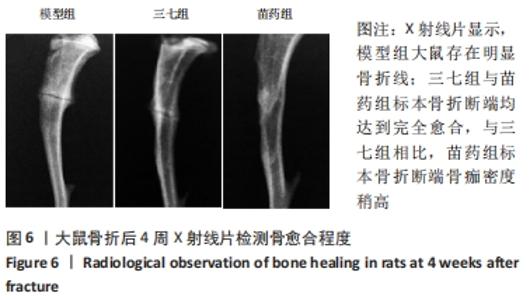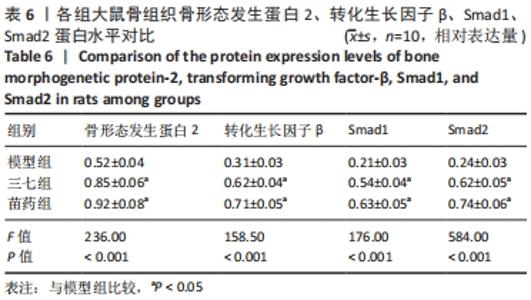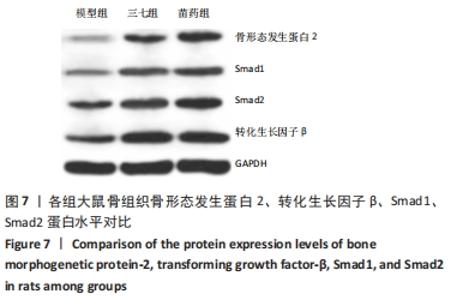Chinese Journal of Tissue Engineering Research ›› 2022, Vol. 26 ›› Issue (33): 5350-5356.doi: 10.12307/2022.808
Previous Articles Next Articles
Effect of Miao medicine Jiuxian Luohan Jiegu Decoction on osteogenic differentiation and fracture healing in tibial fracture rats
Li Yi, Yang Yanjun, Peng Songyun, Cheng Zhigang, Zhong Kai, Yin Tianping, Tang Lianghua
- Second Department of Orthopedics, the Second Affiliated Hospital of Guizhou University of Traditional Chinese Medicine, Guiyang 550001, Guizhou Province, China
-
Received:2021-03-02Accepted:2021-06-09Online:2022-11-28Published:2022-03-31 -
Contact:Tang Lianghua, MD, Chief physician, Master’s supervisor, Second Department of Orthopedics, the Second Affiliated Hospital of Guizhou University of Traditional Chinese Medicine, Guiyang 550001, Guizhou Province, China -
About author:Li Yi, Master, Physician, Second Department of Orthopedics, the Second Affiliated Hospital of Guizhou University of Traditional Chinese Medicine, Guiyang 550001, Guizhou Province, China -
Supported by:the Science and Technology Core Project of Guizhou Provincial Department of Science and Technology, No. LH [2015]7257 (to TLH)
CLC Number:
Cite this article
Li Yi, Yang Yanjun, Peng Songyun, Cheng Zhigang, Zhong Kai, Yin Tianping, Tang Lianghua. Effect of Miao medicine Jiuxian Luohan Jiegu Decoction on osteogenic differentiation and fracture healing in tibial fracture rats[J]. Chinese Journal of Tissue Engineering Research, 2022, 26(33): 5350-5356.
share this article
Add to citation manager EndNote|Reference Manager|ProCite|BibTeX|RefWorks
| [1] LI Y, SHEN S, XIAO Q, et al. Efficacy comparison of double-level and single-level bone transport with Orthofix fixator for treatment of tibia fracture with massive bone defects. Int Orthop. 2020;44(5):957-963. [2] Goey RS, van Drunen B, van der Linden E, et al. Fracture of the tibia after a fibula graft for mandibular reconstruction: A rare complication, report of a case. Clinical Case Reports. 2021;9(5):e03987. [3] CONSORTIUM T. A Randomized Controlled Trial Comparing rhBMP-2/Absorbable Collagen Sponge Versus Autograft for the Treatment of Tibia Fractures With Critical Size Defects. J Orthop Trauma. 2019;33(8): 384-391. [4] 唐良华, 杨彦君. 苗药九仙罗汉接骨汤促进兔胫骨干骨折愈合的动物实验研究[J]. 贵阳中医学院学报,2014,36(1):25-26. [5] 宋敬锋,梁春雨,刘昊,等.强骨胶囊对老年股骨头近段骨折延迟愈合患者血清BMP-2及IGF-1水平的影响[J].现代生物医学进展, 2017,17(7):1255-1258. [6] 张文韬, 段宁, 陈勋,等. 血清血管细胞黏附因子-1、骨形态发生蛋白-2动态监测对尺桡骨骨折延迟愈合的预测价值[J]. 中国临床医生杂志,2019,47(2):198-200. [7] 董瑛,袁小娟,高卉,等.骨折内固定术后感染对Smad通路蛋白的影响及与预后的关系[J]. 实用医学杂志,2019,35(9):1411-1414. [8] 黄琼, 向阳, 曾楚华. 独正杆接骨膏外用对骨折愈合过程中SMAD1/5,SMURF1mRNA表达的影响[J]. 中华中医药学刊,2018, 36(3):543-546. [9] 姜自伟, 曾景奇, 李悦,等. 骨碎补总黄酮对大鼠胫骨牵张末期BMP-2与Smad-1表达的影响[J]. 辽宁中医杂志,2018,45(1):166-168. [10] 罗清龙,唐良华,熊屹,等. 苗药九仙罗汉接骨汤促进SD大鼠胫骨骨折愈合中TGF-β1动态表达[J]. 贵州医药,2019,43(4):24-27. [11] 郭春锋,南子春,石永秀. HMGB1对大鼠胫骨骨折愈合的影响机制[J]. 基因组学与应用生物学,2020,39(9):4378-4384. [12] 吴雪花, 车晓明, 顾勇,等. 水飞蓟素胶囊对大鼠胫骨骨折愈合的促进作用[J]. 中国医院药学杂志,2017,37(19):1909-1913. [13] 屈墨羱, 胡静, 李运峰. 神经轴突导向分子Semaphorin 3A对骨质疏松模型大鼠骨折愈合的影响[J]. 广东医学,2016,37(2):173-177. [14] KAKKAR RS. Malunited proximal third tibia fracture treated with open reduction and internal fixation surgery with a raft plate using the early stage callus as a potential autograft. Indian J Orthop. 2020;6(2):147-151. [15] SCHAFFER NE, WILSON JL, YEE MA, et al. Intramedullary Nail for a Distal Tibia Fracture.J Orthop Trauma. 2020;34 Suppl 2:S37-S38. [16] 陈祥和,彭海霞,李世昌,等.不同运动方式对Ⅱ型糖尿病小鼠骨形成及BMPs/Smad途径相关分子表达的影响[J].北京体育大学学报,2017,40(5):51-58. [17] 熊为,丁金玉,张劲松,等.血府逐瘀汤对股骨颈骨折患者TGF-β、VEGF及BMP-2表达的影响[J].现代生物医学进展,2016,16(5):901-903. [18] 罗艳,胡桂英,叶彬.降钙素调节BMP-2治疗骨质疏松所致骨折的临床价值分析[J].标记免疫分析与临床,2018,25(3):399-402. [19] 王斌,麦彩园,谢胜德,等. Wnt/β-catenin,BMP-2/Runx2/Osterix, OPG/RANKL,LGR4/RANKL通路的相关因子在绝经后骨质疏松性骨折中的表达[J]. 2020,26(11):1577-1583,1658. [20] 韩杰,王大伟,莫坚,等.中药在骨折愈合过程中对TGF-β1表达机制的影响[J].吉林中医药,2016,5(5):494-496. [21] 孙贵耀, 张雪华, 乔晓光,等. 密骨方对股骨粗隆间骨折患者TGF-β1与骨折愈合的影响[J]. 川北医学院学报,2019,34(1):81-84. [22] 曾继涛, 涂小林, 刘宏. TGF-βⅡ型受体小分子抑制剂ITD-1对骨髓基质细胞成骨分化和血管形成的作用[J]. 第三军医大学学报, 2020,42(4):384-391. [23] 杨彦君,熊屹,程志刚,等.苗药九仙罗汉接骨汤干预胫骨干骨折不同时相点的X射线比较[J].中国组织工程研究,2012,16(50): 9311-9315. [24] 燕梦云,依香叫,李金诚,等.刺老苞根皮水提物对成骨细胞TGF-β/BMPs信号通路的影响[J]. 药物评价研究,2017,40(11):1541-1544. [25] 罗清龙, 唐良华, 刘玉召,等. 苗药九仙罗汉接骨汤对SD大鼠胫骨骨折愈合中bFGF基因表达的影响[J]. 亚太传统医药,2018,14(6): 27-29. [26] 安晓晖, 刘恩, 吕飞,等. 基于VEGF/VEGFR-2信号通路探讨穿山龙总皂苷促进去势大鼠骨折血管形成和骨折愈合的效果[J]. 中国中医急症, 2020, 29(5):846-849,869 [27] 温慧敏, 尹小娟, 杨沙,等. 小儿伤科方泡腾颗粒和配方颗粒对闭合性骨折大鼠的治疗效果研究[J]. 解放军医药杂志,2019,31(12): 19-22,28. [28] 冯洋, 陈跃平, 章晓云,等. 骨生长因子调控骨折愈合机制及在骨再生修复中的作用[J]. 中国组织工程研究,2019,23(4):613-620. [29] 黄孝斌,黄河,杨宏泉. 骨伤康颗粒对兔桡骨骨折模型VEGF,NO及ALP表达的影响[J]. 中国中医急症,2020,29(3):423-425,429. [30] 蔡郁,陈小波,朱文清,等. 血清中血管内皮生长因子和血小板源性生长因子与胫腓骨骨折患者骨折愈合及关节功能的关系[J]. 中国卫生检验杂志,2019,29(9):1116-1118. [31] 金培程, 程正江. 闭合复位髓内钉固定治疗股骨干骨折对VEGF,HIF-1α表达的影响[J]. 现代医学,2020,48(2):201-206. [32] 冯宗贤,郑敏哲,徐君翔,等.高压氧辅助治疗胫骨骨折的临床疗效及对血清FGF-2和IGF-1的影响[J].中华航海医学与高气压医学杂志,2019,26(3):239-241. [33] 白秋芳, 邹明, 张继志,等. IGF-1对2,5-己二酮诱导的骨髓间充质干细胞凋亡的拮抗作用研究[J]. 大连医科大学学报,2020,42(1):5-10. [34] 赵子星,李宏宇,席立成,等.体外冲击波疗法联合仙桃草口服用于兔桡骨骨不连临床效果观察[J].山东医药,2016,56(36):31-33. [35] 唐良华,杨彦君.苗药九仙罗汉接骨汤促进兔胫骨干骨折愈合的动物实验研究[J].贵阳中医学院学报,2014,36(1):25-26. [36] 鲍根强,肖春来,张国辉,等.甲状旁腺激素联合降钙素对大鼠骨质疏松性骨折骨生长因子的影响[J]. 中国骨质疏松杂志,2020,26(4): 480-484,489. [37] 杨彦君,熊屹,唐良华,等.苗药九仙罗汉接骨汤干预对兔骨折模型的病理染色变化及血管内皮生长因子表达的作用[J].中国老年学杂志,2015,35(4):1002-1004. [38] 罗清龙,唐良华,熊屹,等.苗药九仙罗汉接骨汤促进SD大鼠胫骨骨折愈合中TGF-β1动态表达[J].贵州医药,2019,43(4):526-529. [39] 杨彦君,熊屹,程志刚,等. 苗药九仙罗汉接骨汤促进胫骨干骨折的愈合[J].中国组织工程研究,2012,16(46):8566-8570. [40] 杨彦君,唐良华. 苗药九仙罗汉接骨汤促进骨折愈合的临床效应[J].贵阳中医学院学报,2013,35(2):265-267. [41] 罗清龙.苗药九仙罗汉接骨汤对大鼠胫骨骨折后TGF--β1、BMP--2、bFGF基因及蛋白动态表达的实验研究及其临床疗效观察[D].贵阳:贵阳中医学院,2018. [42] 熊屹.苗药九仙罗汉接骨汤促进骨折愈合实验研究[C].贵阳:第25届全国脊柱脊髓学术会议暨2013年贵州省骨科年会,2013. [43] 唐良华.苗药九仙罗汉接骨汤干预对兔骨折模型的HE变化及VEGF表达的实验观察[C].贵州省医学会骨科学分会2014年学术年会,2014. |
| [1] | Li Rui, Shi Wen, Yang Shicai, Lü Linwei, Zhang Chunqiu. Effect of splintage and Shenxiaosan cataplasm on fracture healing in rabbits with radial fracture model [J]. Chinese Journal of Tissue Engineering Research, 2022, 26(9): 1329-1333. |
| [2] | Gao Yujin, Peng Shuanglin, Ma Zhichao, Lu Shi, Cao Huayue, Wang Lang, Xiao Jingang. Osteogenic ability of adipose stem cells in diabetic osteoporosis mice [J]. Chinese Journal of Tissue Engineering Research, 2022, 26(7): 999-1004. |
| [3] | Liang Xuezhen, Yang Xi, Li Jiacheng, Luo Di, Xu Bo, Li Gang. Bushen Huoxue capsule regulates osteogenic and adipogenic differentiation of rat bone marrow mesenchymal stem cells via Hedgehog signaling pathway [J]. Chinese Journal of Tissue Engineering Research, 2022, 26(7): 1020-1026. |
| [4] | Dong Yi, Shan Shuai, Liu Jialin, Han Xiangzhen, He Huiyu. Circular RNA mmu_circ_0001775 knockdown improves the osteogenic ability of mouse bone marrow mesenchymal stem cells [J]. Chinese Journal of Tissue Engineering Research, 2022, 26(30): 4767-4772. |
| [5] | Ailimaierdan·Ainiwaer, Muhetaer·Huojia, Wang Ling. Effect of transforming growth factor-beta 3 and bone morphogenetic protein-2 on proliferation and osteogenic differentiation of dental pulp stem cells [J]. Chinese Journal of Tissue Engineering Research, 2022, 26(30): 4862-4866. |
| [6] | Li Xiheng, Li Xinyue, Mao Tianjiao, Yang Wanqi, Tang Liang, Li Jiang. Cannabidiol promotes proliferation and osteogenic differentiation of human periodontal ligament stem cells [J]. Chinese Journal of Tissue Engineering Research, 2022, 26(30): 4867-4872. |
| [7] | Huang Wei, Dong Panfeng, Huang Yourong, Xia Tian. Epimedium in regulating bone marrow mesenchymal stem cell differentiation and preventing osteoporosis related signaling pathways [J]. Chinese Journal of Tissue Engineering Research, 2022, 26(30): 4889-4895. |
| [8] | Liu Zemin, Lü Xin. Application of intramedullary nailing in the treatment of long tubular bone fractures of the extremities: reaming and non-reaming [J]. Chinese Journal of Tissue Engineering Research, 2022, 26(3): 461-467. |
| [9] | Luo Zhen, Huang Yuxi, Chai Shengting, Li Feilong, Chen Qunqun. Bushen Jianpi Huoxue Recipe is closely related to the target of histone demethylase JMJD2B in promoting osteogenic differentiation in osteoporosis: an in vitro cell experimental verification [J]. Chinese Journal of Tissue Engineering Research, 2022, 26(29): 4643-4650. |
| [10] | Wang Jing, Yang Jiuju, Wang Ningning, Liu Chao. Effect of modified three-dimensional-printed titanium scaffold on osteogenic differentiation of adipose-derived mesenchymal stem cells [J]. Chinese Journal of Tissue Engineering Research, 2022, 26(27): 4265-4271. |
| [11] | Gao Zhao, Zhao Yuhao, He Yixiang, Zhao Haiyan, Wang Wenji. DNA hydrogel based on drug delivery and bone tissue engineering [J]. Chinese Journal of Tissue Engineering Research, 2022, 26(27): 4379-4385. |
| [12] | Huang Tao, Jia Zhiqiang, Zhao Xiaoguang, Wang Lei, Fang Liping, Zhai Wenjing, Zhai Shafei, Zhou Yongxin. LncRNA-HOTAIR can regulate differentiation of adipose derived mesenchymal stem cells into osteoblasts [J]. Chinese Journal of Tissue Engineering Research, 2022, 26(25): 3951-3955. |
| [13] | Chen Chichi, Zhang Yu, He Jiachen, Shi Qin. Osteogenic differentiation of bone marrow mesenchymal stem cells in obese mice [J]. Chinese Journal of Tissue Engineering Research, 2022, 26(24): 3846-3851. |
| [14] | You Wulin, Huang Guicheng, Wang Jianwei. Osteogenic differentiation potential of microencapsulated transgenic bone marrow mesenchymal stem cells cocultured with osteoblasts [J]. Chinese Journal of Tissue Engineering Research, 2022, 26(24): 3852-3857. |
| [15] | Cui Yinpeng, Guo Ai, Ma Lifeng, Liu Zhenjiang. Ouabain induces in vitro differentiation of human bone marrow mesenchymal stem cells into osteoblasts [J]. Chinese Journal of Tissue Engineering Research, 2022, 26(24): 3796-3801. |
| Viewed | ||||||
|
Full text |
|
|||||
|
Abstract |
|
|||||
